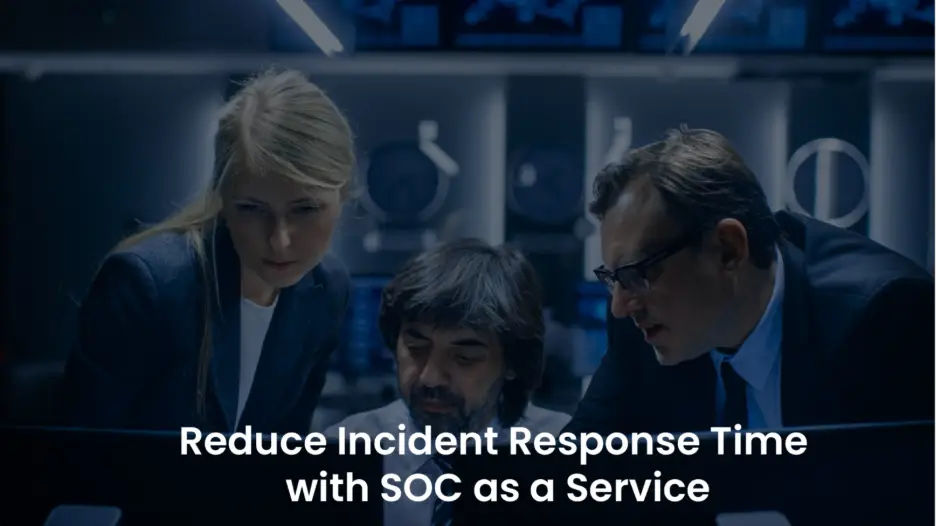
Before diving deep into the realm of SOC as a Service (SOCaaS), it is essential to first comprehend the essential role of a Security Operations Center (SOC), which encompasses its fundamental functions, capabilities, and the critical role it plays in protecting an organization’s digital infrastructure. This foundational knowledge underlines the importance of SOCaaS.
This article explores how SOC as a Service significantly reduces incident response time by elaborating on its importance, best practices, and essential metrics such as MTTD (Mean Time to Detect) and MTTR (Mean Time to Respond). It further details how SOCs ensure continuous monitoring, employ automated triage, and manage responses across cloud and endpoint environments. Additionally, it discusses how the integration of SOCaaS with existing security frameworks enhances visibility and bolsters cybersecurity resilience. This resource provides insights on how a well-structured SOC strategy, regular drills, and effective threat intelligence lead to quicker containment of incidents while highlighting the benefits of utilizing managed SOC services. These services grant access to expert analysts, sophisticated tools, and scalable processes without necessitating the development of in-house capabilities.
Proven Strategies for Effective Incident Response Time Reduction with SOC as a Service
To effectively minimize incident response times using SOC as a Service (SOCaaS), organizations must harmonize technology, streamlined processes, and expert insights to quickly identify and manage potential threats before they escalate into critical situations. A dependable managed SOC provider incorporates continuous monitoring, state-of-the-art automation, and a skilled security team to enhance every aspect of the incident response lifecycle. This synergy ensures that organizations can respond promptly and effectively to cybersecurity incidents.
A Security Operations Center (SOC) acts as the command center for an organization’s cybersecurity framework. When delivered as a managed service, SOCaaS combines critical elements such as threat detection, threat intelligence, and incident management into a unified structure, enabling organizations to respond to security incidents in real-time. This integrated approach ensures that all security incidents are addressed efficiently, significantly improving the overall security posture.
To effectively reduce response times, consider implementing the following methods:
- Continuous Monitoring and Detection: By leveraging advanced security tools and SIEM (Security Information and Event Management) platforms, organizations can meticulously analyze logs and correlate security events across diverse endpoints, networks, and cloud services. This real-time monitoring offers a comprehensive perspective on emerging threats, significantly diminishing detection times and aiding in the prevention of potential breaches.
- Automation and Machine Learning: SOCaaS platforms harness machine learning technologies to automate routine triage tasks, prioritize critical alerts, and initiate predefined containment strategies. Such automation minimizes the time security analysts devote to manual investigations, facilitating quicker and more efficient incident responses.
- Skilled SOC Team with Defined Roles: A managed response team consists of seasoned SOC analysts, cybersecurity experts, and incident response specialists, all functioning with clearly defined roles and responsibilities. This structured approach guarantees that every alert receives prompt and appropriate attention, thus enhancing overall incident management and response effectiveness.
- Integrated Threat Intelligence and Proactive Hunting: Engaging in proactive threat hunting, bolstered by global threat intelligence, empowers organizations to detect suspicious activities early, thereby reducing the risk of successful exploitation and strengthening their incident response capabilities.
- Unified Security Stack for Enhanced Coordination: SOCaaS consolidates various security operations, threat detection, and information security functions under one provider. This integration fosters improved coordination among security operations centers, resulting in expedited response times and reduced resolution times for incidents.
What Makes SOC as a Service Indispensable for Reducing Incident Response Time?
Here are the compelling reasons why SOCaaS is essential:
- Continuous Visibility: SOC as a Service provides real-time visibility across endpoints, networks, and cloud infrastructures, facilitating the early detection of vulnerabilities and unusual behaviors before they escalate into major security breaches.
- 24/7 Monitoring and Swift Response: Managed SOC operations operate around the clock, diligently analyzing security alerts and events. This constant vigilance ensures rapid incident responses and prompt containment of cyber threats, thereby enhancing the overall security posture of the organization.
- Access to Expert Security Teams: Partnering with a managed service provider provides organizations access to highly skilled security experts and incident response teams. These professionals effectively assess, prioritize, and respond to incidents promptly, alleviating the financial burden of sustaining an in-house SOC.
- Automation and Integrated Security Solutions: SOCaaS incorporates advanced security solutions, analytics, and automated response playbooks, streamlining incident response strategies and significantly reducing delays caused by human intervention in threat analysis and remediation.
- Enhanced Threat Intelligence Capabilities: Managed SOC providers leverage global threat intelligence to proactively identify emerging risks within the evolving threat landscape, thereby strengthening an organization’s defenses against potential cyber threats.
- Improved Overall Security Posture: By merging automation with expert analysts and scalable infrastructure, SOCaaS empowers organizations to maintain a robust security posture, meeting contemporary security demands without straining internal resources.
- Strategic Alignment for Enhanced Focus: SOC as a Service allows organizations to focus on strategic security initiatives, while the third-party provider handles daily monitoring, detection, and threat response tasks, effectively lowering the mean time to detect and resolve incidents.
- Real-Time Management of Security Incidents: Integrated SOC monitoring and analytics provide a holistic view of security events, enabling managed security services to swiftly identify, respond to, and recover from potential security incidents with remarkable efficiency.
What Best Practices Can Enhance Incident Response Time When Using SOCaaS?
Here are the most effective best practices:
- Establish a Comprehensive SOC Strategy: Clearly articulate structured processes for detection, escalation, and remediation. A well-defined SOC strategy ensures that each phase of the incident response procedure operates efficiently across various teams, thereby enhancing overall effectiveness.
- Implement Continuous Security Monitoring: Maintain 24/7 security monitoring across all networks, endpoints, and cloud environments. This proactive approach supports early identification of anomalies, significantly shortening the time needed to detect and contain potential threats before they escalate into serious issues.
- Automate Incident Response Workflows for Efficiency: Integrate automation within SOC solutions to hasten triage, analysis, and remediation processes. Automation reduces the need for manual intervention while improving the overall quality of response operations.
- Leverage Managed Cybersecurity Services for Scalability: Partnering with specialized cybersecurity service providers enables organizations to seamlessly scale their services while ensuring expert-led threat detection and mitigation without the operational challenges of maintaining an in-house SOC.
- Conduct Regular Threat Simulations for Preparedness: Execute simulated attacks, including DDoS (Distributed Denial of Service) drills, to evaluate an organization’s security readiness. These simulations help identify operational gaps and refine the incident response process, enhancing overall resilience.
- Enhance Data Security and Visibility Across Systems: SOCaaS platforms consolidate telemetry from multiple systems, providing unified visibility into network, application, and data security layers. This comprehensive view considerably shortens the time between detection and containment of threats.
- Integrate SOC with Existing Security Tools for Cohesion: Align current security tools and platforms within the managed SOC ecosystem to eliminate silos and improve overall security outcomes, fostering a more collaborative security environment.
- Adopt Solutions Compliant with Industry Standards: Collaborate with reputable vendors, such as Palo Alto Networks, to integrate standardized security solutions and frameworks that enhance interoperability while minimizing the occurrence of false positives.
- Measure and Optimize Incident Response Performance Continuously: Regularly track key metrics, including mean time to detect (MTTD) and mean time to respond (MTTR), to pinpoint opportunities for reducing delays in response cycles and enhancing the maturity of SOC operations.
The article Reduce Incident Response Time with SOC as a Service was found on https://limitsofstrategy.com
